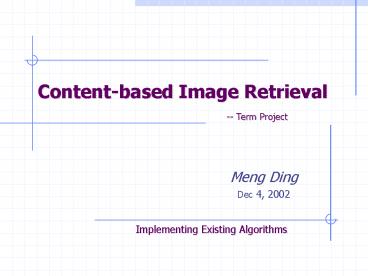Contentbased Image Retrieval Term Project PowerPoint PPT Presentation
1 / 47
Title: Contentbased Image Retrieval Term Project
1
Content-based Image Retrieval -- Term
Project
Meng Ding Dec 4, 2002
Implementing Existing Algorithms
2
Contents
- Introduction
- Implementation
- Evaluation
- Conclusion
3
Introduction
- CBIR based on Low Level Feature Extraction (Level
1) - CBIR based on Sample (Query) Image
4
Introduction
- Low Level Feature Extraction
- 1. Global Histogram Based
- 2. Segmentation Based (finding objects)
5
Introduction
6
Contents
- Introduction
- Implementation
- Evaluation
- Conclusion
7
Implementation Global Hist Based
- Image Preprocessing
- Feature Extraction
- Similarity Measurement
8
Global Hist Based Preprocessing
- Cutting Image Boundaries
9
Global Hist Based Color Histogram
- Convert to HSV Color Space
10
Global Hist Based Color Histogram
- Convert to HSV Color Space
where , ,
, and
is the corresponding point of
in the HSV color space.
11
Global Hist Based Color Histogram
- Quantize into 256 bins with
16 levels in H Channel 4 levels in S Channel 4
levels in V Channel
12
Global Hist Based Edge Histogram
- Convert to YCbCr Color Space
13
Global Hist Based Edge Histogram
- Compute Luminance Gradients
Vertical Horizontal 45
degree 135 degree isotropic
- Threshold 50 for Sum of Gradient Values
- Quantize Edge Histograms into 5 Bins
14
(No Transcript)
15
Global Hist Based Similarity
- Histogram Intersection for Both Color and Edge
Features
16
Global Hist Based Similarity
- Combine Two Features
- Sort overall Distance
- Retrieve top 20 images
where s is the sample image, i is the image in
the image database, dk(I,I) is the result from
histogram intersection for all features and wk is
the weight on each feature value.
17
Implementation Segmentation Based
- Based on UC Berkelys Blobworld
- Three Steps
- 1. Extract color and texture features for
- each pixel
- 2. Grouping of pixels by Expectation
Maximization - Algorithm and Minimum Description Length
- Principle
- 3. Description of Region features and
- Similarity Comparison for Image Query
18
Segmentation Based Color Features
- Convert to Lab Color Space
- L Channel is used for texture extraction
19
Segmentation Based Color Features
- Smooth the image using a smooth filter
20
Segmentation Based Texture Features
- Three Local Texture Descriptors
- Contrast, Anisotropy and Polarity
- Three Local Texture Descriptors
- Contrast, Anisotropy and Polarity
- All features derived from gradients
21
Segmentation Based Texture Features
- Second Moment Matrix (Averaged Squared Gradient
Matrix)
where is the approximation to
a Guassian smoothing kernel with
variance 2.
22
Segmentation Based Texture Features
- Eigenvalues of Second Moment Matrix
- Comparisons between and
23
Segmentation Based Texture Features
- Contrast
- Anisotropy
- Polarity
- Dominant Orientation within local region
24
Segmentation Based Combine Features
- Six Dimensional Features for each pixel
- 1. Smoothed L
- 2. Smoothed a
- 3. Smoothed b
- 4. Contrast c
- 5. Anisotropy ac
- 6. Polarity pc
25
Segmentation Based Build Models
- Selection of K mean vectors
- Two cases when K 3
26
Segmentation Based Build Models
- Evaluate Models using Expectation Maximization
(EM Algorithm) - Initialization
- where X is a feature vector, is
normalized mixing weights (Initial Value 1/K) ,
is the collection of all parameters, f is - Guassian density with
representing K mean vectors, - representing K covariance
matrices and d the number of features
27
Segmentation Based Build Models
- Updates
- Where
is the probability of fits given
parameter .
28
Segmentation Based Choose Model
- Stop Condition
- Stop when does not increase within 10 iterations.
- Choose the Number of Regions K to maximize the
for formula (MDL)
29
Segmentation Based Group Pixels
- Compute Probability Density for Each Pixel Under
the Selected Model - Replace the pixels with label of the cluster for
which it attains the highest likelihood
30
Segmentation Based Group Pixels
- Perform 8-way Connected-Components Algorithm to
find regions - 1 1 0 1 1 0 1 1 1 0 1 1 0
2 - 1 1 0 1 1 0 1 1 1 0 1 1 0 2
- 0 0 1 0 0 0 1 0 0 1 0 0 0 2
31
Segmentation Based Region Description
- Lab color histogram 218 bins with width 20 in
each direction - Mean Contrast Value
- Mean Anisotropy Value
32
Segmentation Based Segmentation Representation
33
(No Transcript)
34
Segmentation Based Similarity Measure
- Histogram Intersection for Color features
- Euclidean distance for texture features
- Combine Color and Texture features using
normalized weights (currently 0.5 for each
feature) - Maximum similarity from all region pairs between
two images - Sort the Maximum similarity value and pick up the
top 20.
35
Contents
- Introduction
- Implementation
- Evaluation
- Conclusion
36
Evaluation Testing Images
- Downloaded from Stanford University Database
Group, 10,000 test images with average size for
each image 128X85 - Segmented images so far 1100, with 1000 images
from the original database and the rest 100
images (Great Walls) added by ourselves (for
convenience of performance comparisons)
37
(No Transcript)
38
(No Transcript)
39
(No Transcript)
40
(No Transcript)
41
Evaluation Comparison
42
(No Transcript)
43
(No Transcript)
44
Evaluation Comparison
45
Contents
- Introduction
- Implementation
- Evaluation
- Conclusion
46
Conclusion
- It works, sometimes even produce good results
- Still a VERY DIFFICULT problem, semantic
retrieval is almost impossible at present - Segmentation based approach is not necessarily
better than Global histogram based approach - Difficult to compare the performance of different
CBIR systems - Impractical for WWW content-based image retrieval
given current knowledge
47
Thank You!

